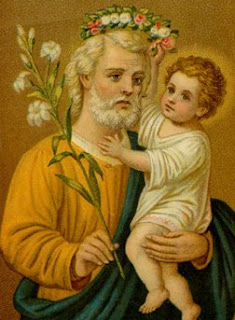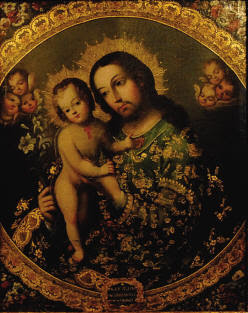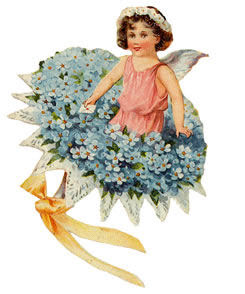
To Joey of course! My DH and I named him after St. Joseph.
For my DH and dear F-i-L whose middle names are Joseph.
To celebrate this morning, I attended Mass and we feasted on waffles, strawberries and whipped cream.


Joseph: Virgin Husband
What were the thoughts of Mary and Joseph on being united under the eyes of God? Ah! They wee surely turned toward Christ who was to come, toward the promised Messiah. The expectation of the Messiah was in the heart of every good Israelite. The Patriarchs, on entering into marriage, had in view primarily the propagation of the race from which the Messiah was to come.
But Mary had promised God to remain a Virgin and that promise was very dear to her. She agreed to marry Joseph, but she would remain a Virgin. And behold, Saint Joseph came into the presence of Mary. At once, enlightened by the Holy Spirit, by a sweet unction, his most pure soul understands that Mary must remain a Virgin, that virginity is essential to her person, inseparable from her. Mary inspires only chaste thoughts. She can be loved only with virginal love. From the first, Joseph is won to the zeal of holy virginity; and their marriage is made on the understanding that they will entrust one another with their virginity. The virginity of Joseph will be the treasure of Mary. What Joseph loves most in Mary is that she is a virgin, so all his love for her consists in guarding very preciously her virginity.
O, who can tell the delights of such a union which is not of the earth? The two souls of Mary and Joseph meet and melt into one another in the ineffable light of a wholly divine fusion, breathing the spiritual perfumes of holy virginity.
- Dom Bernard Marchaux

1. Chaste Lover of Mary, how overwhelmed you were when you thought that you would have to end your betrothal to her. But when the angel of God came to you in a dream, you were filled with awe to realize that Mary would be your wife, and you would be the guardian of the Messiah.
Help us St. Joseph, help our families and all our loved ones to overcome all sadness of heart and develop an absolute trust in God’s goodness.
2. Faithful guardian of Jesus, what a failure you thought you were when you could only provide a stable for the birth of the Holy Child. And then what a wonder it was when shepherds came to tell of angel choirs, and wise men came to adore the King of Kings.
Through your example and prayers, help us St. Joseph and all we love to become like sinless mangers where the Savior of the world may be received with absolute love and respect.
3. Tender-hearted Joseph, you too felt pain when the blood of Jesus was first shed at His circumcision. Yet how proud you were to be the one privileged to give the name Jesus, Savior, to the very Son of God.
Pray for us St. Joseph, that the sacred blood of Christ, poured out for our salvation, may guard our families, so the Divine Name of Jesus may be written in our hearts forever.
4. Joseph, loving husband, how bewildered you were when Simeon spoke the words of warning that the hearts of Jesus and Mary would be pierced with sorrows. Yet his prediction that this would lead to the salvation of innumerable souls filled you with consolation.
Help us, St. Joseph, to see with eyes of faith that even the sorrows and pains of those we deeply love can become the pathway to salvation and eternal life.
5. Courageous protector of the Holy Family, how terrified you were when you had to make the sudden flight with Jesus and Mary to escape the treachery of King Herod and the cruelty of his soldiers. But when you reached Egypt, what satisfaction you had to know that the Savior of the world had come to replace the pagan idols.
Teach us by your example, St. Joseph, to keep far from the false idols of earthly attractions, so that like you, we may be entirely devoted to the service of Jesus and Mary.
6. Ever-obedient Joseph, you trustingly returned to Nazareth at God’s command, in spite of your fear that King Herod’s son might still be a threat to Jesus’ life. Then what fatherly pride you had in seeing Jesus grow in wisdom and grace before God and men under your care.
Show us St. Joseph, how to be free from all useless fear and worry, so we may enjoy the peace of a tranquil conscience, living safely with Jesus and Mary in our hearts.
7. Dependable father and husband, how frantic you and Mary were when, through no fault of yours, you searched for three days to find Jesus. What incredible relief was yours when you found Him safe in the Temple of God.
Help us St. Joseph, never to lose Jesus through the fault of our own sins. But if we should lose Him, lead us back with unwearied sorrow, until we find Him again; so that we, like you, may finally pass from this life, dying safely in the arms of Jesus and Mary.
And Jesus Himself, when he began His work, was about thirty years old being, as was supposed, the son of Joseph.
Pray for us, holy Joseph.
That we may be made worthy of the promises of Christ.
Let us pray.
O blessed St. Joseph, tender-hearted father, faithful guardian of Jesus, chaste spouse of the Mother of God, I pray and beseech you to offer to God the Father my praise to Him through his divine Son, who died on the cross and rose again to give us sinners new life. Through the holy name of Jesus, pray with us that we may obtain from the eternal Father, the favor we ask . . . (Pause) . . . We have been unfaithful to the unfailing love of God the Father; beg of Jesus mercy for us. Amid the splendors of God’s loving presence, do not forget the sorrows of those who suffer, those who pray, those who weep. By your prayers and those of your most holy spouse, our Blessed Lady, may the love of Jesus answer our call of confident hope. Amen.

 Picture source:Not Exactly Rocket Science and who is also celebrating both Pi Day and Albert Einstein's birthday.
Picture source:Not Exactly Rocket Science and who is also celebrating both Pi Day and Albert Einstein's birthday.

Monday Wash DayIf anyone knows the author, please let me know so I can give proper credit.
Lord, help me wash away all
my selfishness and vanity,
so I may serve you with
perfect humility through the week ahead.
Tuesday Ironing Day
Dear Lord, help me iron out
all the wrinkles of prejudice
I have collected through the years
so that I may see the beauty in others.
Wednesday Mending Day
O God, help me mend my ways
so I will not set a bad example for others.
Thursday Cleaning Day
Lord Jesus, help me to dust out
all the many faults I have been hiding
in the secret corners of my heart.
Friday Shopping Day
O God, give me the grace to shop wisely
so I may purchase eternal happiness
for myself and all others in need of love.
Saturday Cooking Day
Help me, my Savior,
to brew a big kettle of brotherly love
and serve it with clean,
sweet bread of human kindness.
Sunday The Lord's Day
O God, I have prepared my house for you.
Please come into my heart so
I may spend the day and
the rest of my life in your presence.
 Photo source Joyces Images and used with permission.
Photo source Joyces Images and used with permission.





The altarpiece consists of a total of twenty-four compartmented scenes, which make up two views, open and closed, which are changed by moving the hinged outer wings. The upper register (row) of the opened view shows Christ the King (but see below) between the Virgin Mary and John the Baptist. The insides of the wings represent angels singing and making music, and on the outside Adam and Eve. The lower register of the central panel shows the adoration of the Lamb of God, with several groups in attendance and streaming in to worship, overseen by the dove representing the Holy Spirit. On week days the wings were closed, showing the Annunciation of Mary and donor portraits of Joost Vijdt and his wife Lysbette Borluut.Source: Wikipedia
As the defining monument of the "new realism" of Northern Renaissance art, the Ghent Altarpiece was regarded as both the foundation of a distinguished tradition, and an exemplary achievement to challenge all later artists. In 1495, an early visitor named Hieronymus Münzer justly described it as encompassing the whole art of painting.To learn more about this intricate work of art, visit The Metropolitan Museum of Art the source of the above article.
The discovery in 1823 of a rhymed quatrain on the frame of the altarpiece confirmed that it was begun by Hubert van Eyck, and even described him as greater than his more famous brother Jan, who completed the work upon Hubert's death in 1426. No one has ever convincingly distinguished their respective shares in this painting. Dedicated on May 6, 1432 in the Church of Saint John, Ghent (now the Cathedral of Saint Bavo), the work was installed above an altar in a chantry chapel founded by the wealthy patrician Joos Vijd and his wife Elizabeth Borluut.

The Chaldean archbishop of Mosul is dead. Archbishop Faraj Rahho was kidnapped last February 29 after the Stations of the Cross. His kidnappers gave word of his death, indicating to the mediators where they could recover the body of the 67-year-old prelate. "It is a heavy Cross for our Church, ahead of Easter", Bishop Rabban of Arbil tells AsiaNews in response to the news. Leaders of the Chaldean Church, including Bishop Shlemon Warduni, brought the body to the hospital in Mosul to ascertain the causes, still unknown, of the archbishop's death. The funeral will be held tomorrow in the nearby city of Karamles. Archbishop Rahho will be buried near Fr Ragheed, his priest and secretary killed by a terrorist brigade on June 3, 2007, while leaving the church after celebrating Mass.Asia News Article
(Born and raised in Hawaii, Patricia Devlin is the mother of two children and holds advanced degrees in psychology and counseling. She has been blind since birth, and has survived two bouts with cancer. She currently suffers from migraines and breast cancer. Her book, The Light of Love, is a compilation of conversations with her guardian angel, and later with our Lord. She lives in Lubbock, Texas and is under spiritual direction there with a priest of her diocese, in obedience to the bishop.)

Helping Catholics discover their deeper individual selves and to strengthen their relationship with God through prayer, meditation, discernment and reflective living…

For Don Bosco, the Immaculate Virgin, Mary Help of Christians, was the ever-present Mother who helps her children daily, going to their rescue and leading them to Jesus. "Be devoted to Mary Help of Christians", he would habitually say, "and you will see what miracles are!".Second pillar: devotion to Jesus in the Eucharist
The second pillar of Don Bosco's spirituality was devotion to Jesus in theThird pillar: educational system based on joy, hope
Eucharist, which he saw as the heart of every Salesian house. He used to remind young people: "If you want many graces, pay many visits to Jesus in the Sacrament; if you want few graces, pay him few".
Don Bosco was a "vir eucharisticus", that is, a saint formed through and through by the Eucharist. He was so passionate about the Eucharist that he communicated his passion to the young people he carefully prepared for communion with the Lord through the sacrament of Reconciliation. For Don Bosco, Confession and the Eucharist were the two sacraments that inculcated in young people the Christian virtues and holiness.
On this topic he wrote in 1877:
"Frequent Confession, frequent Communion and daily Mass are the pillars that must support an educational building that we desire to protect from threats and scourges. Never force youngsters to receive the holy sacraments, but only encourage them and make it easy for them to do so" (John Bosco, Il sistema preventivo nella educazione della gioventù [1877], n. 4).
The 15-year-old St Dominic Savio is a shining example of this sacramental pedagogy which strengthened his virtuous habits and his union with Jesus, witnessed by his Eucharistic ecstasies during Holy Communion.
The third pillar of Don Bosco's spirituality was his educational system of joy and hope. Dominic Savio, who once said to Don Bosco: "I am the fabric, you are the tailor; make me into a beautiful suit for the Lord!", had fully grasped this when he suggested to his young companions: "Let's make holiness consist in being very cheerful!"...Fourth pillar: devotion to Church and Vicar of Christ
..."Run, jump, amuse yourselves as much as you like, but for pity's sake, don't sin!"...
Don Bosco's fourth and last pillar is his devotion to the Church, to her Pastors and especially to the Holy Father. His love for the Pope was extraordinary and is an integral part of the Salesian formation and apostolate.To read the above text in its entirety please visit EWTN's Library: The Four Pillars of Salesian Spirituality.

It is a lack of self-control that makes me--
lash out at my brother in a burst of anger,
show impatience with my neighbor,
talk about the faults of others,
speak before I think,
be intemperate in things that cause me pleasure,
buy things I cannot afford,
be brutally frank and caustic at times,
and
criticize the faults of others publicly.

His name is Bill. He has wild hair, wears a T-shirt with holes in it, jeans, and no shoes. This was literally his wardrobe for his entire four years of college.
He is brilliant. Kind of profound and very, very bright. He became a Christian while attending college.
Across the street from the campus is a well-dressed, very conservative church. They want to develop a ministry to the students but are not sure how to go about it.
One day Bill decides to go there. He walks in with no shoes, jeans, his T-shirt, and wild hair. The service has already started and so Bill starts down the aisle looking for a seat.
The church is completely packed and he can't find a seat. By now, people are really looking a bit uncomfortable, but no one says anything.
Bill gets closer and closer and closer to the pulpit, and when he realizes there are no seats, he just squats down right on the carpet.
By now the people are really uptight, and the tension in the air is thick.
About this time, the minister realizes that from way at the back of the church, a deacon is slowly making his way toward Bill.
Now the deacon is in his eighties, has silver-gray hair, and a three-piece suit. A godly man, very elegant, very dignified, very courtly. He walks with a cane and, as he starts walking toward this boy, everyone is saying to themselves that you can't blame him for what he's going to do.
How can you expect a man of his age and of his background to understand some college kid on the floor?
It takes a long time for the man to reach the boy.
The church is utterly silent except for the clicking of the man's cane. All eyes are focused on him. You can't even hear anyone breathing. The minister can't even preach the sermon until the deacon does what he has to do.
And then they see this elderly man drop his cane on the floor. With great difficulty, he lowers himself and sits down next to Bill and worships with him so he won't be alone..
Everyone chokes up with emotion. When the minister regains control, he says, "What I'm about to preach, you will never remember. What you have just seen, you will never forget. "
"Be careful how you live. You may be the only Bible some people will ever read!"

Do people know that YOU care and do YOU look for opportunities to be a blessing to others?
Consider this my friends ....
Instead of complaining because your paycheck is too small, be grateful that you even have a paycheck. Consider the many thousands of people who are unemployed and frightened because they do not know where the next meal will come from to feed their families.
Instead of asking "what is in it for me?" consider what you YOU can do for a fellow member of God's human family as opposed to doing "it" simply because it benefits YOU.
Instead of spending five dollars on a pack of cigarettes or fifty dollars on a college or pro sporting event, why not send that five or fifty dollars to an organization or agency that helps abused children get back on track with their lives?
Instead of feeling sorry for yourself because YOU are alone, why not visit an aging brother or sister living in a senior home or a child in a hospital who truly understand the meaning of lonliness.
Instead of complaining about your boss, supervisor or co-workers, why not consider that they are people too. Consider that they are people who are loved just like you and people who are depended upon, just like you. They may not always be fair, right, or agreeable, but are we when it comes to others? Think about that!
Instead of complaining because YOU think that God isn't doing enough to change the world, why not start by looking at the world YOU live in and change that?
Instead of asking for raise after raise to support your indulgent excessiveness, why not become less material, needy, and wanting and more economical, practical, and sensible. Ask yourself, "Is it something I truly need, or just something that I want?" There is a difference.
I can go on, but I believe WE get the picture here.
"People don't care what you know, they just want to know that you care." It doesn't get any simpler than that.
I am ready to become a blessing to others. Are you?
Sincerely,
Carlos Michael Padilla

On March 9 the Catholic church honors the feast of St Dominic Savio. He is the patron saint of the youth, choir boys, and falsely accused. He was an ordinary boy with an extraordinary love for God. He was a gentle, calm and cheerful lad who puts great efforts into his studies, helps others in every way, teaches the Catechism, tends the sick, sorts quarrels and other tasks. He was described by Pope Pius XI as “small in size, but a towering giant in spirit.” He set up the ‘Sodality of Mary Immaculate’ with a group of friends to carry out his apostolic work
When St Dominic received his first communion at the age of seven, he wrote down the following as his plan of life: “I will go to confession very often and go to communion as often as my confessor gives me permission. I will celebrate Sundays and feast days as holy days. Jesus and Mary will be my friends. Death rather than sin.”
“You have many good boys, but none can match the good heart and soul of Dominic. I see him so often at prayer, staying in church after the others; every day he slips out of the playground to make a visit to the Blessed Sacrament. When he is in church he is like an angel living in Paradise.”- Mamma Margaret, remarked to his son St John Bosco about St Dominic SavioI highly recommend The Life of St. Dominic Savio by St. John Bosco.
“In other circumstances, Dominic might have become a little self-righteous snob, but Don Bosco showed him the heroism of the ordinary and the sanctity of common sense.” -Rev. Clifford Stevens, The One Year Book of Saints